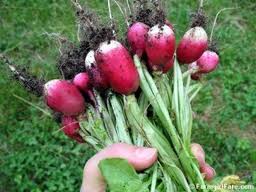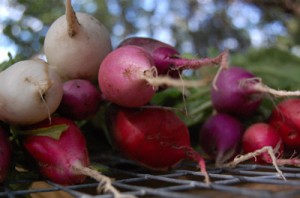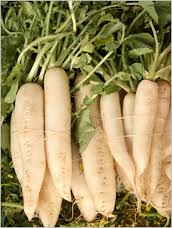Radish

Summer Radish
Radishes have often been dismissed as decoration and garnish. They are actually members of the cruciferous vegetable family so eat the greens. Because they vary in keeping quality, radishes are classified as winter or summer. Summer radishes are the small ones of bold red, pink, purple, white or red and white. They may be globe-shaped or elongated, fiery hot or mild.
Harvest summer radishes when they are small and tender for optimal flavor. Oversize summer radishes can become tough, woody, hallow and strong in flavor. To check a large radish squeeze gently, if it yields to pressure it is likely to be fibrous. These will do well in the compost heap.
Winter Radish
Harvest winter radishes when they are large and mature. Winter radishes may be white, black or green. Black radishes have a pungent flavor and should be used sparingly. Remove greens and roots before storing black radishes. Chinese radishes, round and fat, are milder in flavor. Remove greens before storing; remove roots just before preparing.
The word daikon means “great root” in Japanese. In cool weather, daikon growth is quick and steady. The fully mature daikon can grow up to about 18 inches long and weighs 5 or 6 pounds. There are several varieties. Some are thin and long, while others are short and round. All radish greens are edible.
Sourced from: http://urbanext.illinois.edu/veggies/radish.cfm
Easter Egg Radish Daikon Radish
French Breakfast Radish
Storage
Save the young thinnings of both summer and winter radishes. They are delicious with tops and bottoms intact. Both summer and winter radishes store well in the refrigerator once the tops have been removed. The radish leaves cause moisture and nutrient loss during storage. Store greens separately for 2-3 days. Refrigerate radishes wrapped in plastic bags for 5 to 7 days. Winter radish varieties can be stored for up to two weeks in the refrigerator.
Preparation & Cooking Tips
Preparation & Serving
Summer and winter radishes are most often eaten raw. Use a stiff vegetable brush and scrub radishes under cold running water. Do not peel summer or black radishes. Pare away the top and root end then slice, dice, shred, or serve whole. Large Chinese and Japanese varieties hold up well during cooking. They can be eaten raw, preserved or substituted in any recipe calling for turnips.
Daikon radishes are thought to aid in digestion, especially the digestion of fatty foods. It is a common ingredient in Japanese cooking and is always grated and added to tempura dipping sauce. Young daikons can be eaten raw but the larger (more than 8 inches long) ones must be cooked. Always peel daikons. Cut up and simmered in stews and soups, daikon tastes light and refreshing rather than heavy or starchy. Daikons are often cut into paper-thin slices by talented Japanese chefs.
Daikon greens are delicious too. They can be washed, stacked, rolled into a scroll, and cut crosswise. This produces thin julienne strips which are traditionally salted and left standing for an hour. The moisture is squeezed out. The leaves are then chopped and stored in glass jars for up to a week in the refrigerator. The Japanese stir them into warm rice, they can also be added to soups and other recipes.
Nutrition
Nutrition Facts (1/2 cup fresh sliced raw red globes)
Calories 12
Protein 0.35 grams
Carbohydrates 2.0 grams
Dietary Fiber 1 gram
Potassium 134.56 mg
Folate 15.66 mcg



